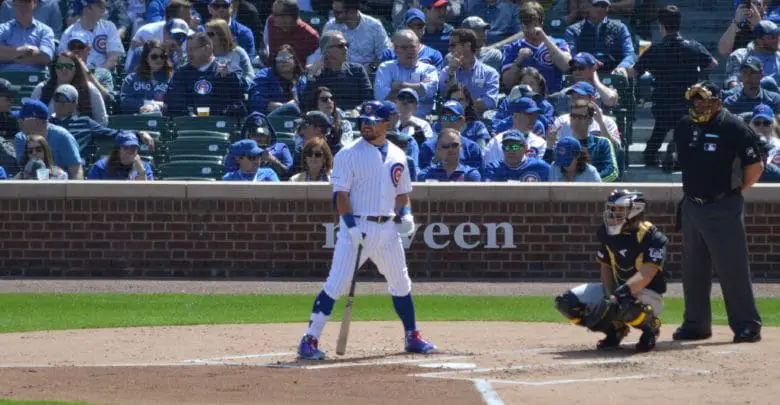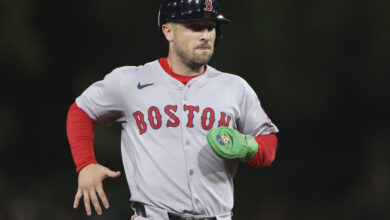
Kyle Schwarber’s Passive Two-Strike Approach Needs to Change
Something needs to change with Kyle Schwarber‘s plate approach. He has struck out at least once in his last 11 games and his strikeout percentage has actually increased from 26.1 to 32.5 since being elevated to the leadoff spot in mid-May. His average and OBP have dropped from .224/.341 to .200/.313 in that same time, not exactly what you’re looking for in a leadoff hitter.
It should be noted that his wOBA and wRC+ have actually improved from .309 and 90 to .327 and 101, but those still aren’t up to expectations. So what gives? Well, the real issue here seems to be that the slugger is too patient at the plate. This is something we’ve noted in the past and it’s actually gotten worse this season.
“Worse” is admittedly a really unsatisfying way to describe a hitter’s acute awareness of the strike zone, so understand that I’m using it for lack of a better term. As his career has advanced, it’s as though Schwarber has dug in his heels and refused to budge in his approach in spite of results that scream for him to make changes.
On the surface, you’d look at his team-leading 4.22 pitches per plate appearance and 14.7% walk rate as positive signs. And they are…to an extent. Patience may be a virtue, but there’s a point at which it becomes paralyzing. It seems that Schwarber is getting too comfortable taking pitches, which has resulted in an abnormally high number of looking strikeouts.
Though his looking-strike percentage (29.4) this season is only slightly elevated over his career mark (27.8) and isn’t alarming relative to league average (26.4), he goes down looking 60% more frequently than his peers. Seriously. Called third strikes make up 37.1% of Schwarber’s total strikeouts, while the league as a whole takes them at a mere 23.2% clip.
It’s as though he gets into a groove of taking and allows passivity to control the at-bat from that point. His .148 average (13-for-88) through 0-2 and 1-2 counts isn’t going to get anyone excited, but it’s nearly three times higher than his aggregate .057 average (2-for-35) through 2-0, 3-0, and 3-1 counts. It’s as though pitchers have him right where they want him once they fall behind.
How can he even be hitting as high as .205 given those marks? Well, he’s got a .300 average (6-for-20) when he puts the first pitch in play, further proof that a more patient approach isn’t necessarily better. While 20 at-bats is admittedly too small a sample upon which to base conclusions, there’s a much larger pool of data to suggest that hitters in general — and Schwarber in particular — are at a disadvantage in deep counts.
A study by Boston University Master Lecturer Mark T. Williams and a team of graduate students at the Questrom School of Business culled data from nearly four million pitches over 11 seasons in order to determine how to fix the strike zone. They found over 34,000 missed calls last season alone, the largest percentage of which came at the top corners and bottom right of the zone

With that in mind, let’s take a look at a heatmap that displays two-strike pitch location to Schwarber this season.

By golly, it’s almost as if those regions match right up with what the study shows are trouble spots for umpires. I’d love to tell you I went back and looked at all of Schwarber’s strikeouts this season, but that would be a lie. By memory alone, I’d say he’s taken a lot of called third strikes at the corners, particularly outside and/or low.
I did take a look at his last four strikeouts, three of which have been called, with the pitch locations as follows: upper left, lower left, outside right. Two of those looked to be strikes by all accounts, but the Adam Wainwright curve that got him in the 6th inning Sunday was not. And I’m guessing if I looked back further, I’d find more of the same.
Rather than simply rely on my own recollection, I’m leaning on the very obvious two-strike bias shown to pitchers by the arbiters of balls and strikes.
Research results demonstrate that umpires in certain circumstances overwhelmingly favored the pitcher over the batter. For a batter with a two-strike count, umpires were twice as likely to call a true ball a strike (29 percent of the time) than when the count was lower (15 percent). These error rates have declined since 2008 (35.20 percent), but still are too high. During the 2018 season, this two-strike count error rate was 21.50 percent and repeated 2,107 times. The impact of constant miscalls include overinflated pitcher strikeout percentages and suppressed batting averages. Last season, umpires were three times more likely to incorrectly send a batter back to the dugout than to miss a ball-4 walk call (7 percent). Based on the 11 regular seasons worth of data analyzed, almost one third of batters called out looking at third strikes had good reason to be angry [emphasis mine].
Though there are certainly some legitimate strikes Schwarber is taking incorrectly, his approach and the way pitchers attack him seems tailor-made for these strike-zone “blind spots” revealed by the study. As such, he’s almost got to throw it back to Little League and become significantly more aggressive in protecting the plate with two strikes.
And therein lies another issue, since making contact with pitches in the locations in question isn’t likely to produce ideal results. But given Schwarber’s power and improving contact rates, he’s at least got the chance to foul it off or shoot the ball to the opposite field. That’s certainly better than being rung up. Well, unless he’s grounding into double plays.
If we were talking about a guy who was hitting .250 or so and getting good results when working deep counts, we could probably chalk the looking strikeouts up to an aberration. But Schwarber’s looking-strikeout percentage has increased markedly each season and there’s a very clear bias in the way umpires call pitches, which offers a wealth of evidence in favor of a change in his plate approach.
Though it’s too simple to just say that he needs to be more aggressive, that’s exactly what it comes down to in the end. Whether it’s jumping on more first pitches to ambush mistakes or expanding and protecting deep in the count, Schwarber would do well to be more liberal in his appraisal of the zone.
Ed. note: I’d like to offer a word of thanks to Bleed Cubbie Blue’s Sara Sanchez, who clued me in to the BU study over beers at Hopleaf recently.

